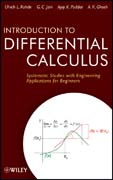
Introduction to differential calculus: systematic studies with engineering applications for beginners
Rohde, Ulrich L.
Jain, G.C.
Poddar, Ajay K.
This book explores the differential calculus and its plentiful applications in engineering and the physical sciences. The first six chapters offer a refresher of algebra, geometry, coordinate geometry, trigonometry, the concept of function, etc. since these topics are vital to the complete understanding of calculus. The book then moves on to the concept of limit of a function. Suitable examples of algebraic functions are selected, and their limits are discussed to visualize all possible situations that may occur in evaluating limit of afunction, other than algebraic functions. Also, applications and limitations of this definition, along with the algebra of limits (i.e. limit theorems) arediscussed. Finally, Sandwich theorem, which is useful for evaluating limit(s)of trigonometric functions, is proved, and the concept of onesided limits is introduced. The methods for computing limits of algebraic functions are discussed, and the concept of continuity and related concepts are also featured at length. Suitable examples of functions and their graphs are selected carefully to prevent reader confusion. Classification of the points of discontinuity is explained, and the methods for checking continuity of functions involving trigonometric, exponential, and logarithmic functions are discussed through solvedexamples. Theorems on continuity of functions (i.e. algebra of continuous functions) are stated without proof. Also, very important theorems on continuity(without proof) are provided. INDICE: Chapter One. From Arithmetic to Algebra. Chapter Two. The Concept of Function. Chapter Three. Discovery of Real Numbers (Through Traditional Algebra). Chapter Four. From Geometry to Co-ordinate Geometry. Chapter Five. Trigonometry and Trigonometric Functions. Chapter Six. More about Functions. Chapter Seven. (a): The Concept of Limit of a Function. Chapter Seven. (b): Methodsfor Computing Limits of Algebraic Functions. Chapter Eight. The Concept of Continuity of a Function and the Points of Discontinuity. Chapter Nine. The Ideaof Derivative of a Function. Chapter Ten. Algebra of Derivatives: Rules for Computing Derivatives of Various Combinations of Differentiable Functions. Chapter Eleven. (a): Basic Trigonometric Limits and Their Applications in Computing Derivatives of Trigonometric Functions. Chapter Eleven. (b): Methods of Computing Limits of Trigonometric Functions. Chapter Twelve: Exponential Form(s) of a Positive Real Numbers and its Logarithms. Chapter Thirteen. (a): Exponential and Logarithmic Functions as Their Derivatives. Chapter Thirteen. (b): Methods for Computing Limits and Exponential and Logarithmic Functions. Chapter Fourteen. Inverse Trigonometric Functions and Their Derivatives. Chapter Fifteen. (a): Implicit Functions and Their Differentiation. Chapter Fifteen. (b): Parametric Functions and Their Differentiation. Chapter Sixteen. Differentials dyand dx: Meanings and Applications. Chapter Seventeen. Derivatives and Differentials of Higher Order. Chapter Eighteen. Applications of Derivatives in Studying Motion in a Straight Line. Chapter Nineteen. (a): Increasing and Decreasing Functions and the Sign of the First Derivative. Chapter Nineteen. (b): Maximum and Minimum Values of a Function. Chapter Twenty. Rolles Theorem and the Mean Value Theorem (MVT). Chapter Twenty One. The Generalized Mean Value Theorem(Cauchys MVT), LHospitals Rule, and Its Applications. Chapter Twenty Two. Extending the Mean Value Theorem to taylors Formula: Taylor Polynomials for Certain Functions. Chapter Twenty Three. Hyperbolic Functions and Their Properties.
- ISBN: 978-1-118-11775-0
- Editorial: John Wiley & Sons
- Encuadernacion: Cartoné
- Páginas: 728
- Fecha Publicación: 06/01/2012
- Nº Volúmenes: 1
- Idioma: Inglés
- Inicio /
- MATEMÁTICAS /
- CÁLCULO
